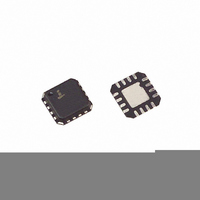ISL6297CRZ-T Intersil, ISL6297CRZ-T Datasheet - Page 15

ISL6297CRZ-T
Manufacturer Part Number
ISL6297CRZ-T
Description
IC CHARGER LI-ION POLYMER 16-QFN
Manufacturer
Intersil
Datasheet
1.ISL6297CRZ-T.pdf
(16 pages)
Specifications of ISL6297CRZ-T
Function
Charge Management
Battery Type
Lithium-Ion (Li-Ion), Lithium-Polymer (Li-Pol)
Voltage - Supply
4.3 V ~ 6.5 V
Operating Temperature
-20°C ~ 70°C
Mounting Type
Surface Mount
Package / Case
16-VQFN Exposed Pad, 16-HVQFN, 16-SQFN, 16-DHVQFN
Lead Free Status / RoHS Status
Lead free / RoHS Compliant
Other names
ISL6297CRZ-TTR
Hysteresis Temperature Calculation
Re-arranging Equation 8, and including the effect of R
gives:
Using the K/(1-K) ratio at the hysteresis threshold, Equation
18 provides the NTC thermistor resistance at the threshold.
Continuing the example above, the thermistor values are
found to be 26.2kΩ and 7.3kΩ respectively at the low and
high hysteresis temperatures. The corresponding
temperatures are found from Table 3. Cold recovery is about
+1.0°C and the hot recovery is about +33.9°C. In other
words, the hysteresis temperatures for the low and high
limits are approximately +6.1°C and +11.0°C, respectively.
Temperature Tolerance Calculation
The temperature accuracy is affected by the accuracy of the
thresholds, R
maximum ratio K, maximum possible R
results in the maximum value of R
From the “Electrical Specifications” table, the maximum K at
cold is found to be 0.71. Assuming the resistors have 1%
accuracy, the maximum R
is 40.8Ω. The resultant maximum R
36.3kΩ and the corresponding temperature is about
negative +6.4°C. Hence the temperature tolerance is
+1.3°C. Similarly, at high temperature, the minimum K is
0.24, the minimum R
R
the tolerance is +1.1°C.
Charging Temperature Range
The selection of R
where R
and the R
temperature difference above +45°C. Figure 13 shows the
temperature windows before, during, and after charging.
From the example, before and after charging, the
temperature window is -5°C to +45°C with +6°C and +4°C
hysteresis. During charging, the high temperature limit
changes to +45°C + ΔT. If this limit is exceeded, the charger
is stopped and the temperature has to come back to below
+41°C for the charging to be allowed again. The low
temperature limit is also increased. However, the R
typically has a much lower resistance than the NTC at low
temperature, therefore, the influence on the temperature
threshold is not as much as at high temperature. Typically,
R
R
R
S
TMAX
D
T
is 41.6Ω. Hence, the highest temperature is +46.0°C and
=
=
------------ -
1 K
R
T
K
–
=
T
(
(@+45°C) is the thermistor resistance at +45°C
T
@45
------------------------ -
1 K
(@+45°C + ΔT) is the resistance at some desired
×
K
–
R
S
MAX
o
U
, R
MAX
C
–
) R
U
R
D
–
, and the NTC thermistor. Using the
S
×
follows Equation 20:
U
R
T
(
UMAX
value is 14.85kΩ and the maximum
@45
U
is 15.15kΩ and the minimum R
o
15
–
C
R
+
SMIN
ΔT
T
from Equation 18, that is:
T
)
is then found to be
U
, and minimum R
D
(EQ. 18)
(EQ. 20)
(EQ. 19)
S
,
S
S
ISL6297
the low temperature threshold is raised by less than +2°C,
as shown in Figure 13.
2.9V Bias Voltage
A pre-regulator provides a regulated 2.9V on the V2P9 pin,
unless V
output voltage tracks the input voltage with a 250mV dropout
voltage. The 2.9V output turns off when V
VIN (falling) threshold. A minimum 0.1μF X5R ceramic
capacitor is required for decoupling the pre-regulator.
The V2P9 output is used for biasing external circuits. The
maximum loading current on this pin is 30mA. Mainly, the
load current comes from the indication LEDs.
Board Layout Recommendations
The ISL6297 is targeted for space-limited applications. In
order to maximize the current capability, it is very important
that the exposed pad under the package is properly soldered
to the board and is connected to other layers through
thermal vias. More thermal vias and more copper attached to
the exposed pad usually result in better thermal
performance. On the other hand, the number of vias is
limited by the size of the pad. The exposed pads for the 4x4
QFN package are able to have 5 vias. As much copper as
possible should be connected to the exposed pad to
minimize the thermal impedance. Refer to the ISL6297
evaluation board for layout examples.
Related Literature
• Technical Brief TB363 “Guidelines for Handling and
• Technical Brief TB379 “Thermal Characterization of
• Technical Brief TB389 “PCB Land Pattern Design and
FIGURE 13. BOARD TEMPERATURE MONITORING. WHEN
Processing Moisture Sensitive Surface Mount Devices
(SMDs)”
Packaged Semiconductor Devices”
Surface Mount Guidelines for QFN Packages”
+45°C+ Δ T
+44.7°C
+32.0°C
+0.6°C
-5.1°C
IN
drops below 2.9V plus 250mV (typical). Then the
NOT CHARGING, THE TEMPERATURE WINDOW
IS BETWEEN -5°C AND +45°C. ONCE THE
CHARGER STARTS, THE TEMPERATURE
WINDOW IS ~-3°C TO +45°C+ ΔT
LESS THAN
+2°C
IN
drops below the
July 30, 2007
FN9215.2







